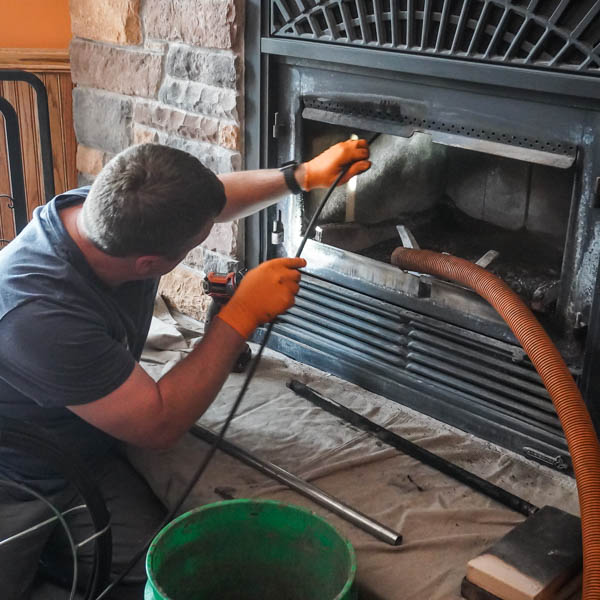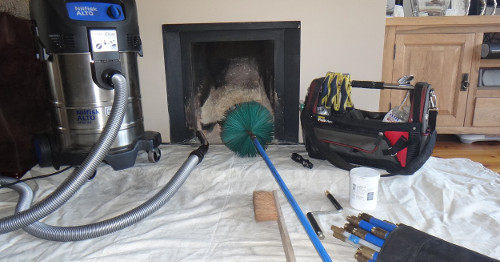Just How to Recognize Common Problems That Require Smokeshaft Repair Work in your house
Recognizing common problems that require smokeshaft repair in your home is vital for preserving both safety and effectiveness. Normal inspections can reveal significant signs such as creosote build-up, noticeable splits, and indicators of moisture intrusion. Additionally, odors and draft issues commonly signify much deeper difficulties that may not be right away obvious. Understanding these indication is vital for prompt intervention, yet numerous homeowners neglect them. What are the certain actions one can require to guarantee their smokeshaft stays in optimum condition? The answer might discover greater than you anticipate.

Signs of Creosote Buildup
Among the most important indications of smokeshaft concerns is the build-up of creosote, a result of wood burning. This compound types when smoke cools and condenses on the walls of the smokeshaft, resulting in a thick, tar-like residue. Gradually, creosote accumulation can position significant security dangers, including an increased risk of chimney fires.
Homeowners need to be vigilant in observing indications of creosote build-up. One main indicator is the visibility of a solid, poignant smell emanating from the chimney or fire place, specifically during cooler months when the fireplace remains in usage. san jose chimney repair. Furthermore, dark, shiny deposits on the smokeshaft flue or in the firebox may indicate too much creosote accumulation
Routine assessments can aid determine the degree of the issue. It is recommended that a specialist chimney sweeper carries out a yearly evaluation to analyze creosote levels and execute essential cleansings. If property owners observe any kind of adjustments in the efficiency of their fireplace, such as minimized draft or difficulty in starting a fire, it may show a creosote issue. Dealing with these signs without delay is necessary to preserving a risk-free and reliable chimney system.
Visible Fractures and Damages

Noticeable fractures and damages in a smokeshaft can act as significant caution indications of underlying architectural problems that might need immediate interest. These flaws can develop from various aspects, including temperature variations, clearing up of the home, and deterioration of products gradually. It is essential to analyze both the interior and outside of the smokeshaft for any indicators of cracking, spalling, or collapsing stonework.
Hairline cracks may show minor settling, while bigger cracks might signal a much more serious architectural concession. Property owners need to likewise be mindful of any leaning or turning of the smokeshaft, as this can position safety and security risks and suggest fundamental issues.
Routine inspections by a qualified specialist can identify these visible indications early, preventing much more considerable repairs down the line. If you discover any kind of cracks or damage, it is a good idea to consult a chimney expert who can assess the circumstance and suggest ideal repair choices (san jose chimney repair). Neglecting noticeable splits can lead to enhanced expenses and prospective dangers in the future, emphasizing the importance of timely intervention
Water Leaks and Moisture
Determining water leakages and wetness intrusion in a chimney is crucial for preserving the honesty of both the smokeshaft framework and the home. Water infiltration can lead to significant damage over time, including structural deterioration, mold growth, and compromised safety. Among one of the most usual indications of wetness problems is the existence of efflorescence, which appears as white, grainy deposits on the smokeshaft's outside. This takes place when water vaporizes, leaving behind mineral salts.
In addition, home owners must examine for signs of water discolorations on interior walls or ceilings near the smokeshaft, as these may indicate leakages. Regular examination of blinking, the product that seals the smokeshaft to the roofing, is important. Damaged or poorly installed blinking can enable water to seep right into the chimney framework.
During hefty rainfall or snowmelt, take note of pooling water near the smokeshaft base or on the roofing. This can signify inappropriate drain or clogs that need to be resolved. Regular maintenance and timely repairs are essential in avoiding moisture-related concerns, guaranteeing the smokeshaft remains practical and safe for use.
Undesirable Odors

An additional possible resource of smell is animal breach. Birds, raccoons, or various other wild animals might nest in the smokeshaft, causing the disintegration of natural products, which produces nasty smells. In such situations, it is vital to attend to the trouble immediately to make certain both the safety and security and convenience of your family.
In addition, stationary air in a chimney can add to moldy odors, frequently indicating a lack of correct air flow. Keeping appropriate air flow is necessary to avoid these issues and ensure the reliable procedure of your chimney system.
Regular inspections and cleaning by an expert Source can help identify learn this here now and fix these odor-related issues, protecting your home from future complications.
Poor Draft and Smoke Issues
A persistent inadequate draft in a chimney can significantly prevent the effective operation of a fire place or wood stove, bring about smoke-related problems that compromise interior air quality. This condition frequently results in smoke rippling back right into the home, developing discomfort and possible wellness hazards for occupants.
Numerous variables can contribute to poor draft problems. Clogs brought on by creosote buildup, particles, or animal nests can stop proper air flow, forcing smoke to reverse instructions. Furthermore, a poorly sized flue or chimney can harm ventilation, making it hard for smoke to leave successfully.
Climate condition, such as strong winds or low air pressure, can likewise impact smokeshaft efficiency, aggravating draft concerns. Homeowners may discover signs like extreme smoke, remaining smells, or problem beginning fires.
It is critical to resolve these issues without delay, as long term direct exposure to smoke can bring about respiratory system concerns and various other health and wellness worries. Routine chimney evaluations and maintenance are important to determine and correct poor draft conditions. Consulting a specialist smokeshaft move can make sure complete cleansing and assessment, restoring optimal capability to your smokeshaft system and improving the safety of your home.
Conclusion
In recap, routine evaluation of chimneys linked here is crucial for recognizing typical issues that require fixing. Indications such as creosote buildup, noticeable fractures, water leaks, undesirable odors, and poor draft problems serve as crucial indications of prospective problems. Resolving these problems proactively can enhance the safety and security and effectiveness of the smokeshaft system, eventually protecting against more severe damages and making certain ideal performance. Homeowners must continue to be alert in checking these indications to keep a functional and secure chimney framework - san jose chimney repair.